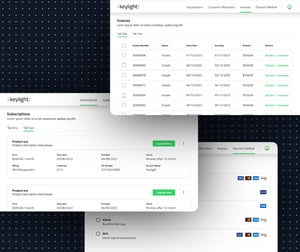Subscription revenue optimization
People, process, and technology in recurring revenue
There's sometimes a bit of a misconception that tech-based subscription business platforms undervalue the role of human input. On the contrary, what keylight specifically is set up to do, is support people better and to make it easier for teams to get on with doing their jobs to the best of their ability.
By making information easy to find, store, set up, process and stay connected, skilled individuals don't waste time doing admin, but instead focusing on the most fulfilling parts of their job, particularly when it comes to the revenue operations teams. In this article we explore how the right technology can help you focus strategically on revenue operations in your subscription business.
Having the right subscription technology can increase the success
of integrating and optimizing the customer journey, sales, billing,
and accounting in revenue strategies.
Typical challenges facing revenue operations teams
Solutions to build an agile and scalable strategy
As Forbes puts it: "The customer experience has emerged as the primary basis of competition as digitally enabled customers armed with better information and access are putting a premium on speed, agility, personalized content, and channel integration. This has created pressure on organizations to establish a single cross functional commercial process across the enterprise and coordinate across management systems and platforms to ensure a unified customer experience as the performance goal."
Technology is not everything, but having the right tech can help revenue operations teams to focus on strategy by saving time on building and aligning processes or waiting for technical teams to develop bespoke functionalities in different systems.
Here are some of the most common challenges facing revenue
operations teams and how the right technology can help

Dispersed tools across teams
A lack of connectivity between systems is one of the biggest frustrations we've come across within revenue operations teams. It's one of those things where once you've experienced the alternative it's hard to imagine how you managed for so long.
Lots of companies have disconnected systems and tools that have been accumulated over time. Most of these will not have been developed specifically for subscription businesses, and instead will have a subject specific leaning—perhaps they were created with a native focus on marketing automation, sales quotes or customer support, for example. Furthermore, each system and functionality will most likely be at a different maturity level, making the custom development to connect them and develop functionalities together almost impossible.
In subscription businesses, more than any other, connectivity between platforms is essential for managing everything, including revenue operations, giving them the flexibility needed for a company to grow and evolve. For example, where a traditional sales tool will enable basic functions, it won't be built with the necessary logic to automate subscription contract changes, which is fine if you only have one client. However, it’s ripe for error and time consumption at scale, unless every team member knows the system like the back of their hand. That, in turn, can have a negative impact on the customer experience.
That said, while connectivity between systems is important, not every team needs access to everything all the time—that in itself can be unnecessarily overwhelming. A unified approach alone cannot only reduce project complexity and often at a premium. There needs to be a balance between a unified system and one that enables flexibility.
How tech can help
keylight has the flexibility to embed components in a unified system that you choose. It offers the opportunity to build continuous and dynamic customer relationships with the logic to automate recurring, and sometimes conditional recurring, processes for flexibility, instead of using expensive and binary custom system modifications.
Sales team or channel onboarding
Onboarding products, pricing and dependencies for customer segments can be tricky when managing large or international sales organizations, especially if you have channel reselling partners to consider as well. Growing product catalogs as well as individual customizations, offers and conditions tailored to individuals can become cumbersome to track, and can lead to errors such as compounding discounts that get lost in the system.
Finding the right product can also be incredibly confusing and time consuming for teams who want to focus on maximizing revenue and getting on with their job. Done manually, these customizations mean revenue operations teams can easily lose clarity on what's going on due to architectural complexity and communication issues.
How tech can help
Predefined conditions and guided-selling can simplify the processes to enable sales teams and partners to sell to customers more easily, which is an important capability in maximizing revenue, team productivity and job satisfaction as well. Having technologies in place that natively support this can help the revenue operations team to save time on alignment, define clear processes as well as fortify and scale revenue.
Clearly defining strategic and operational roles, making sure sales processes are tailored for customer segments is vital for optimizing the customer lifetime value, but to do that in an informed and strategic way requires technology that creates a set of processes that are both uniform for the brand and flexible enough to tailor to individual use cases. This minimizes the team's time worrying about how to create the right product, reduces the risk of error and maximizes the customer's likelihood of getting the right result for them. In turn, that's most likely to lead to retaining their customers long-term.
Data and analytics
Data continues to be king in the digital world, and for revenue operations teams, the right data is fundamental to understanding the customer and their relationship with key touch points in the customer journey. This is hard to achieve with lots of different, disconnected platforms, tools and manual processes in place. For example, in conventional subscription billing solutions, transaction events are the primary type of information by which teams analyze customer journeys. Doing things this way makes seeing the relationships between customer actions such as upgrades and downgrades challenging—if not limited to guesswork.How tech can help
To achieve that all-important bird's-eye view of revenue and performance, revenue operations teams not only need a unified subscription platform, but also one that collects the right customer events, allowing teams to see the relation between them.
Having a unified platform that is built with the customer journey in mind and that collects events in a way that can be understood for the customer behavior means that teams see an ongoing dialogue between the customer and their actions. This helps the team to better understand what they want, where issues may lie, and how to improve sales outcomes.
How keylight can help
Optimize and grow your subscription revenue
keylight is the only company with a dedicated subscription business platform designed specifically to overcome the challenges of subscription organizations, and to optimize commercial outcomes. The system has been built with applications, functionalities, and UI tailored to each user group, helping all users, including people within the organization to maximize their workplace experience and achievements.
We are not a CRM, an ERP or a billing-focused subscription tool. keylight is an end-to-end, flexible business engine that offers comprehensive capabilities for teams, with an extremely flexible foundation that works in harmony with other platforms.
The business system supports internal processes and functions between systems thanks to its API-first, event-driven approach. It not only connects well with other platforms but also enables user-centric data events that help businesses to stay ahead of the game in all revenue-related activities. That helps to maximize sales and minimize customer churn.
Meanwhile, the structure means that different applications are tailored for every user group, so while people are informed, they don’t have to operate in all environments at all times, distracted by things they don’t need .
With this in place, teams can work on one system that offers a unified data source to give a more informed view of product, sales and customer behaviors.

Power your business
with the right subscription solutions
Book a free consultation with >keylight/
Power your business
with the right subscription solutions
Book a free consultation with >keylight/

Explore keylight's superior value compared to conventional subscription platforms
Compare now
Explore keylight's superior value compared to conventional subscription platforms
Compare now




